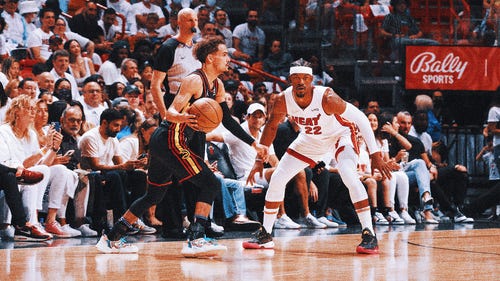
Lakers must firm up defense in Game 5
There’s no question that Phoenix simply out-shot, out-hustled, and out-rebounded the Lakers in Game 4, but there were two other reasons why the defending champs went down.
No. 1, Alvin Gentry outcoached Phil Jackson in the fourth quarter.
No. 2, the Lakers’ defense could not cope with the Suns’ screen-and-rolls.
Offense was not the problem. Contrary to popular opinion, over the course of the first three quarters, the Lakers had no trouble scoring against the Suns' 2-3 zone. During that stretch, L.A. tallied 54 points in 43 possessions vs. the zone. True, many of those points resulted from Kobe Bryant’s phenomenal long-distance shooting — but that’s just Kobe being Kobe.
In addition, the Lakers registered 12 points when they rushed to attack the zone before the Suns could man their spots.
In the fourth quarter, however, Alvin Gentry made a slight adjustment that basically took Kobe out of the game: He simply pointed the zone at Kobe, ordering up a loose double team that made Kobe hesitate before seriously looking for his shot. That slight hesitation was enough for the rest of the zoners to realign themselves so that they could more easily converge on Kobe’s drives and/or pull-ups.
That’s primarily why the Lakers' zone efficiency in the last period fell to only eight points in 13 possessions.
Also, zones are designed to cope with attacks from the top because that’s when there are five players between the ball and the basket. In the initial three quarters, however, Kobe did most of his scoring when receiving the ball on a wing where there were only two defenders between him and the rim. Yet in the decisive fourth quarter, Kobe spent most of his ball-time in the middle of the court.
The fault for that lies with Kobe and Jackson.
In Game 5, L.A. must try to duplicate the offensive success it enjoyed for three quarters. Put Pau Gasol on the left box (his favorite post-up side) and Kobe on the left wing. This formation will force the Suns' left-side interior defender (usually Amar'e Stoudemire) to choose between guarding Gasol or coming out to harass Kobe. If he decides to stay with Gasol, then Kobe gets a clean look at the basket. If he decides to advance on Kobe, then Gasol can easily seal the middle interior defender and do his normal point-making work in the pivot.
But again, offense wasn't the main issue for the Lakers. Their shoddy defense is ultimately what did them in. Specifically, the inefficient manner in which they tried to counter the Suns' screen/rolls.
This has been a Lakers' weakness all season long. The bigs do a fairly decent job of showing on the weak side of the screen, but the guard/wing who is initially screened gets lost in limbo. What this screenee should be doing is to tailgate his man and catch up to him while he’s being detained by the big. After the momentary double-team, the Lakers' big can then quickly retreat into the paint and find another big to guard.
But in order for this dance to work, the baseline rotations have to be prompt and precise. Too bad Andrew Bynum’s cover-up rotations were either late, not forthcoming, or positioned so close to the rim as to be useless. Nor was the baseline help provided by Gasol or Lamar Odom much better.
With the rollers so open, the Lakers were compelled to collapse their entire defense, but in so doing they left the Suns' 3-point marksmen unguarded. Note how many of the Suns' bonus shots were taken without a defender in the vicinity.
On the other hand, the Lakers had great difficulty hindering ball-penetration. If the Suns weren’t turning the corner off a S/R, or curling off a pin-down screen, they simply executed straight-out drives. When the defensive help failed to arrive, the result was several uncontested layups. When the help was late, the ball was already so close to the rim that none of the gathering defenders had enough time to close out the Suns perimeter shooters.
OK, what can be expected when the series returns to L.A.?
Phoenix probably won’t shoot as well on a foreign court.
The Suns won’t get the benefit of so many questionable foul calls.
The Lakers will play with an increased sense of urgency.
Even so, there’s one major adjustment that Jackson can make that could bring the series back into their control.
Since it’s standard operating procedure to give a team a taste of its own medicine, i.e., run a running team, press a pressing team, the Lakers could stymie the Suns' explosive offense by employing a zone.
This would close the middle to drivers, make a jump shooter out of Stoudemire, and get more players involved in defending their defensive glass. However, since the Suns' second unit has several hours of practice against the first team’s 2-3 zone, the Lakers should show them a different formation. Perhaps a 1-3-1 that, at a certain point, transforms into a man-to-man. Or else, some sort of match-up zone that plays man on the strong side and zones the weak side.
Actually, this idea of initially showing zone and then — depending on the shot clock and the position of the ball — falling back into a man-to-man defense is something that Jackson has thought about doing since he coached the Bulls.
Since business as usual hasn’t showed any profit in the last two games, why not turn these thoughts into action?
Whatever adjustments, re-adjustments, and counter-adjustments will be made, the only certainty is that this intriguing humanoid chess match will resume on Thursday.








